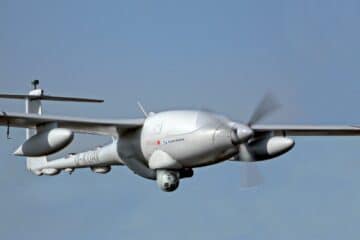EDA press release
The OCEAN2020 Live Sea Demonstration involves a total of 9 unmanned assets and six naval units from Italy, Spain, Greece and France. The deployment of manned and unmanned systems, when integrated with satellite and communication networks, aims to enhance overall maritime situational awareness and build a comprehensive picture of developing situations for military decision-makers.
“Today Ocean 2020 is demonstrating its technical achievements, but also that joint research and development at the EU level works. With the preparatory action on defence research we started small. But it helped us to gain valuable experience for the fully-fledged European Defence Fund in place in 2021 to further strengthen the competitiveness of our defence industries.”
Pierre Delsaux, Deputy Director General, DG GROW – European Commission,
Led by Leonardo, the OCEAN2020 (Open Cooperation for European mAritime awareNess) maritime initiative brings together technical specialists in the maritime domain covering the observing, orienting, deciding and acting operational tasks. In the Mediterranean Sea Demonstration, OCEAN2020 brings together data and information from a variety of sources; 9 unmanned assets – four aircraft, three surface and two underwater, six naval units, five satellites for communication and surveillance, four National Maritime Operations Centres (MOC), two ground communication networks and a prototype of a European Maritime Operations Centre (EU MOC) to build a comprehensive maritime picture.
The two-day live demonstration is the latest phase in the ambitious project which aims to demonstrate enhanced situational awareness in a maritime environment through the integration of legacy and new technologies for unmanned systems. OCEAN2020 aims to achieve operational and technical objectives, these range from enhanced situational awareness, autonomy, cost effectiveness and increased interoperability for joint missions also using protocols compatible with NATO standards. The variety of assets involved in OCEAN2020 highlights how collaborative autonomy between multi-domain unmanned vehicles can provide a force multiplier.
“OCEAN2020 is an incredibly ambitious project. To deliver it, we are bringing together a pan-European team of experts, each of which is contributing its own area of world-class capabilities. Operationally, this project is important demonstrating the possibility to enhance maritime surveillance – of vital interest to European defence – integrating unmanned platforms with traditional systems. More broadly, OCEAN2020 demonstrates the potential and the true spirit of European collaboration in the defence sector, having enabled a real partnership of large and small industry, academia and defence ministries from across the continent.”
Giovanni Soccodato, Chief Strategic Equity Officer at Leonardo

FROM SEA TO EDA: EU MOC PROTOTYPE IN BRUSSELS
To highlight the capability of OCEAN2020 to a wider audience, a prototype of an EU MOC was installed at EDA in Brussels. Today, a demonstration took place offering an opportunity for OCEAN2020 consortium members, project stakeholders and members of the press to discuss the impact of the project and follow the exercise taking place in Italy live via the EU MOC.
“Today’s demonstration is proof of the added-value of EU supported defence research. In deploying 9 unmanned assets, naval assets and integrating them with an extensive satellite and communication networks, OCEAN2020 takes the aims of PADR and puts them into the operational domain where the benefits of European defence cooperation are confirmed.”
Jorge Domecq, EDA Chief Executive
FIRST SEA DEMONSTRATION 20-21 NOVEMBER 2019
Today’s Mediterranean Sea Demonstration, led by the Italian Navy, tests how the fusion of data and information collected from the assets deployed in the area of operations can be integrated to create a Recognised Maritime Picture (RMP). OCEAN2020 aims to show how multiple information sources can be integrated with Combat Management Systems (CMSs) to create a RMP, while equally highlighting how collaborative autonomy between multi-domain unmanned vehicles can provide a force multiplier. The demonstration runs two scenarios; a threatening vessel interdiction and interception of a mine laying vessel before an amphibious operation.
BALTIC SEA 2020
A second Live Sea Demonstration will take place in Summer 2020 in the Baltic Sea and will be led by the Swedish Navy
BACKGROUND
Funded from the European Union’s Preparatory Action on Defence Research under grant agreement No 801697, OCEAN2020 received funding of €35.48 Million. Since its launch in April 2018 the project has undertaken extensive research and technology work to reach the point of undertaking a live sea demonstration. The consortium have been involved in a significant amount of solution analysis, system design, technical development and system integration of individual assets and trials.






